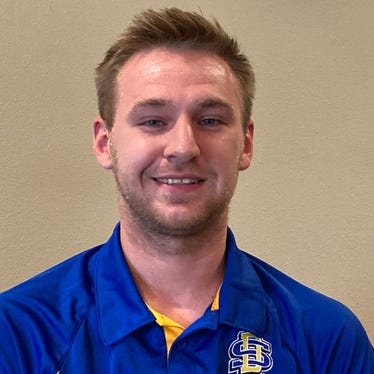
U.S. corn farmers have long believed that they raise the best corn in the world. Jordan Jansen recently put U.S. corn to the test in hog feeding trials against corn raised in Brazil and Argentina.
Jansen, a Coleridge, Neb., native and animal science graduate from the University of Nebraska-Lincoln, who is now working on a master’s degree in swine nutrition at South Dakota State University, conducted a two-part study using the trifecta-sourced corn at SDSU.
The first part of the corn trial involved 10 barrows that were cannulated to “look at the digesta from the digestive system of each individual pig,” Jansen says. “Over a four-week period, we collected digesta, froze it and ground it down so that we could look at amino acid levels and other performance measures to determine what that feed in the digestive system is doing for each pig.”
During the first phase of the research trial, diets were made at SDSU with corn from the Northern Crops Institute (NCI) at North Dakota State University. Acting as a marker for digestibility, titanium dioxide was added into the diets.
“We can run a certain titanium analysis test on the digesta and diets to make sure that the feed is digested correctly by each pig,” Jansen says.
 GRAD RESEARCH: Jordan Jansen, a graduate student in swine nutrition at South Dakota State University, was one of the researchers behind the weaned pig trials. (Kevin Schulz)
GRAD RESEARCH: Jordan Jansen, a graduate student in swine nutrition at South Dakota State University, was one of the researchers behind the weaned pig trials. (Kevin Schulz)

The digesta and feed will also undergo crude protein analysis to determine their nitrogen levels. Also, samples of the digesta were shipped to the University of Missouri for an amino acid analysis; results are forthcoming. Jansen also collected blood from the pigs to analyze the serum for other factors.
“For the university part, we have to know what the individual amino acid levels are, not only in the feed, but in the digestive samples,” says Bob Thaler, SDSU Extension swine specialist and Jansen’s adviser. “Also, since some ethanol trials indicate that U.S. corn has higher starch concentrations than corn from Argentina and Brazil, it’s essential to know how much energy pigs can get from each of the corn sources.”
Pigs like U.S. corn
The second phase of Jansen’s corn research was a 25-day feeding trial on 20-pound weaned pigs, pitting U.S. corn against Argentine and Brazilian corn. Jansen found U.S. corn performs better in pig diets when compared to corn sourced from other countries, in this case, Brazil and Argentina.
Regardless of origin, all corn was sourced through Solla Animal Nutrition in Colombia, where individual lots of 5 tons each were divided into labeled 50-kilogram bags and loaded into a 20-foot sealed container destined for NCI.
In the third phase of the feeding trial, 96 mixed-sex, weaned pigs, between 20 to 30 days old, with average starting weights of 20 pounds, were used. Manufactured at NCI, their diets were fed in three treatments, one for each corn origin. Each treatment was replicated eight times.
Pigs were weighed weekly, and the U.S. corn-based diet separated itself from the others as early as Week 1. The average daily gain (ADG) for the pigs on the U.S. corn diet was 1.75 pounds, compared with 1.59 pounds for the Brazilian corn and 1.55 pounds for the Argentine corn.
Thaler says Argentine and Brazilian corn tends to be more of a hard flint corn, “so it doesn’t break apart as much. Ours isn’t, but it’s got more starch. Our international buyers, when they see U.S. corn being unloaded, it sometimes is dustier and with broken kernels. But if you look at the nutrients, or what the pig or the chicken need, it’s all there. Actually, it’s more than what you’d have in Brazil, in Argentina.”
Pigs on the U.S. corn diets bested those on the South American corn diets in Week 1 average daily feed intake at 1.46 pounds. Pigs consuming the Argentine and Brazilian corn diets came in at 1.52 and 1.53 pounds ADFI, respectively. Week 1 gain-to-feed ratio came in at 1.21 for the U.S. diet, versus 1.04 and 1.07 for Argentine and Brazilian corn, respectively.
Overall performance for the duration of the 25-day trial shows pigs on the U.S. corn diet maintaining an edge at 1.65 pounds ADG, compared with 1.6 and 1.59 for Brazilian and Argentine corn diets, respectively.
Average daily feed intake for the full trial are:
2.16 for Brazil
2.14 for U.S.
2.13 for Argentina
Gain-to-feed ratio for the 25-day trial shows pigs at:
0.77 for U.S. corn diet
0.75 for Argentine corn
0.74 for Brazilian corn
Thaler says Ukrainian corn was supposed to be included in the comparison but arrived too late for this trial. A similar U.S.-Ukraine corn feeding comparison will be done in January, with graduate student Caitlyn Sullivan.
These studies are possible through grants from the Minnesota Corn Research & Promotion Council, the North Dakota Corn Council and the U.S. Grains Council. In addition to the pig feeding trials, Thaler says Auburn University conducted similar trials with poultry, and the NCI researched variations in milling efficiencies.
Don’t forget the boar
In addition to the corn feeding trials, Jansen researched how higher levels of phytase, with or without betaine, in boar diets can improve semen output and quality under heat stress through the summer.
“If you talk to most people in the boar industry, they’re going to say that a boar basically needs a maintenance diet to live, and that’s all they really need to perform at a high level. I’m not entirely convinced that’s true,” he says.
Jansen modeled his research after similar work done a few years back by Kara Stewart, associate professor of animal science at Purdue University, but in a commercial boar stud using 96 boars. Results from that study are also forthcoming.
About the Author(s)
You May Also Like






